Which cranes were used for the heaviest lifts?
05 December 2023
Huge and impressive lifts, both onshore and offshore, from around the world. Niamh Marriott reports.
Despite boasting some of the biggest offshore wind farms in the UK, a recent auction for offshore wind projects failed to attract any bids, leading the government to change the amount to pay for renewable electricity by more than 50 per cent. Companies in the offshore sector say this is due to rising inflation and interest rates. It is hoped this change will encourage future projects in the region, which will of course require some seriously heavy lifts.
A new giant
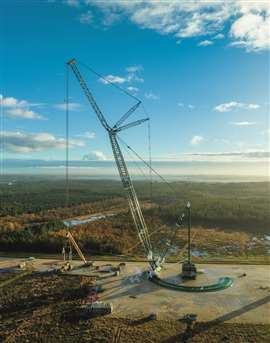 BMS’ new 3,000 tonne capacity ring crane. (Photo: BMS)
BMS’ new 3,000 tonne capacity ring crane. (Photo: BMS)
Lifting specialist BMS has erected its new 3,000 tonne capacity ring crane on a test site in Denmark. Preparations are ongoing for a heavy test lift of 1,530 tonnes.
At full height the BMS Ringer Crane (See ICST January 2022) stands at 245 metres. Even at a hook height of 225 metres the capacity is 1,000 tonnes. On a hook height of 200 metres the crane can lift 1,200 metric tonnes.
With its luffing jib the crane can pick up components and lift around objects, for example, in refineries. It is also ideally suited for the next generations of wind turbines, BMS says, for example, the big floating offshore type.
Low ground pressure is a key feature allowing the crane to operate at places where earlier cranes needed extensive improvements along a quayside.
Its winches are fully electrically driven and can be accurately controlled. This setup allows fast hoisting speeds while keeping the required maintenance to a minimum, BMS explains. All drives are electronically controlled for high accuracy.
Slewing through 180 degrees around the ring with a full load takes 15 minutes. To mobilise the BMS Ringer Crane takes six to eight weeks.
New lifting
Gearing up for large offshore jobs, Allseas has updated the capabilities of its vessel Pioneering Spirit with a new jacket lift system. Integral to the system are two 170 metre hinged beams with integrated tail extensions, built to install and remove entire jackets up to 20,000 tonnes in a single lift and designed to operate in bad weather.
The Switzerland-headquartered company has landed a major contract that will involve one of the world’s heaviest ever offshore installation operations. The contractor has been selected by Aker BP to transport and install the huge 24,000 tonne production, drilling and quarters deck atop a steel jacket as part of the Noaka project offshore in Norway.
The contract award follows the completion of front-end engineering and design work for a single-lift transport and installation solution tailored to Allseas’ heavy lift vessel. Allseas head of projects, Matthijs Groenewegen, says, “It will be one of the heaviest offshore installation projects in history”.
Offshore installation
Van Oord’s heavy lift installation vessel, Svanen, has already installed more than 700 foundations throughout Europe and the vast majority of monopiles in the Baltic Sea. It recently installed the first of 50 monopiles for the Baltic Eagle offshore wind farm, located 30 kilometres northeast of the German island of Rügen.
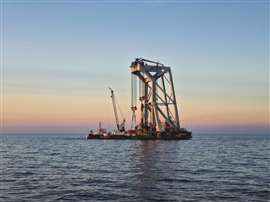 Van Oord’s heavy lift installation vessel, Svanen, recently installed the first of 50 monopiles for the Baltic Eagle offshore wind farm. (Photo: Van Oord)
Van Oord’s heavy lift installation vessel, Svanen, recently installed the first of 50 monopiles for the Baltic Eagle offshore wind farm. (Photo: Van Oord)
With a production capacity of 476 MW, Iberdrola’s Baltic Eagle offshore wind farm is scheduled to be fully operational by the end of 2024.
The installation strategy for the foundations is based on the feeder concept, which involves floating the foundations to the Svanen at the offshore installation site. The monopiles are being transported to the site from EEW in Rostock, Germany. Once they have arrived, Svanen lifts them upright. After precise positioning by the gripper, pile-driving begins. Van Oord already started transportation of the transition pieces from the port of Aviles in Spain to the Van Oord site at the port of Mukran in Germany, at the beginning of March.
The transition pieces are scheduled to be installed later this year. Van Oord’s cable-laying vessel Nexus and trencher Dig-It will be deployed to install and bury the inter-array cables.
Van Oord says the Baltic holds incredible potential for offshore wind in Europe. Germany and several other countries, including Poland, Sweden, Finland and Estonia, are exploring new opportunities for offshore wind.
Wind farm first
In the USA, Van Oord’s offshore installation vessel Aeolus installed the first of 12 turbines at the South Fork offshore wind farm, the first offshore wind project in the State of New York.
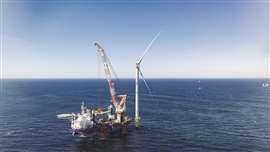 In the USA Van Oord’s offshore installation vessel Aeolus installed the first of 12 turbines at the South Fork offshore wind farm. (Photo: Van Oord)
In the USA Van Oord’s offshore installation vessel Aeolus installed the first of 12 turbines at the South Fork offshore wind farm. (Photo: Van Oord)
Van Oord was chosen by the 50-50 joint venture partnership between Ørsted and Eversource for the transport and installation of wind turbine generators.
Offshore installation vessel Aeolus has recently undergone a major crane upgrade, which includes a new, longer boom on its existing crane. With this new 133 metre long boom, Aeolus is capable of installing the newest generation of turbines for offshore wind projects. Installation work at South Fork Wind will be supported by a fleet of American vessels, including barges, tugs and other support vessels.
Stormy weather
Heavy lifting work around the world continues to impress with heavy lift specialist Sarens recently working on a major project in Adana, Turkey.
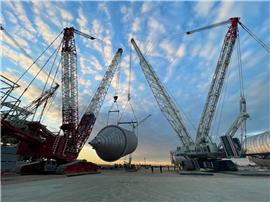 Sarens cranes recently working on a major project in Adana, Turkey. (Photo: Sarens)
Sarens cranes recently working on a major project in Adana, Turkey. (Photo: Sarens)
Despite an earthquake, high winds, and strong rains delaying work, the Sarens teams, on behalf of its client Gemont Endüstri Tesisleri İmalat ve Montaj. and project owner SASAPolyester, completed 41 lifts.
Sarens used a Demag CC 8800-1 with boom booster, a Liebherr LR 1750 and a CC 2400-1 as well as smaller mobile cranes to complete the work which included lifting a 700 tonne, 22 metre oxidation reactor, a 700 tonne, 52 metre rectification column, and five 350 tonne, 52 metre silos. To install each silo, the CC 8800-1 crawled about 100 metres, then lifted in tandem with the LR 1750.
The equipment arrived from Germany within eight days, although customs clearance took another 26 days. Then it was transported to the job site in three days and assembled within 18 days. The main crane was transported via 100 trailers between the port and job site, and 12 the jib sections were brought in on 12 trailers from Croatia.
World first
Dutch heave compensation specialist Seaqualize completed what it claims as the world’s first offshore transfer lifts of wind turbine components from a heaving supply vessel.
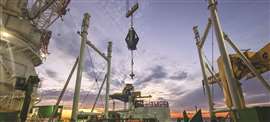 Seaqualize’s newly developed offshore lifting device is being deployed by DEME Offshore US. (Photo: Seaqualize)
Seaqualize’s newly developed offshore lifting device is being deployed by DEME Offshore US. (Photo: Seaqualize)
The newly developed offshore lifting device, the Heave Chief 1100, is deployed by DEME Offshore US. Together with the feeder barge solution developed by DEME Offshore US with partners Barge Master, Foss Maritime and Seaqualize, and the operators and equipment from GE Renewables, this technology will ensure that the Halliade X 13 MW turbines can be installed year round, to form the first commercial scale wind farm installation project in the USA, Vineyard Wind.
Gjalt Lindeboom, managing director at Seaqualize, says, “Some will say: ’Haven’t we done floating lifts for years already in the oil and gas industry? The answer is ‘yes’, but not at this scale, frequency and with such delicate, standard components. In oil and gas, it is not uncommon to wait several days or even weeks to execute one single safe floating transfer lift of, for example, a heavy platform top side, or vessel module. It only has to be done once and that is the project. Furthermore, the component is usually engineered and fabricated to withstand any undesired transport, lifting or installation loads, simply by adding protective steel.”
The Vineyard Wind project will require more than 800 lifts, with loads ranging from 10 to 1,000 tonnes.
Lindeboom adds, “We are very proud of these first successful fast-lifts and the contract and co-operation with DEME. In addition, the second Seaqualize Heave Chief, the HC750, is about to start operations this month, on another wind farm installation project ramping up in the US. We are currently planning the production of additional machines to support projects in 2024 up to 2026.”
Module moves
Heavy lift specialist Mammoet has also been completing some seriously big lifts, including working on the latest phase of the BP-operated Azeri Central East (ACE) project, in the Azerbaijani sector of the Caspian sea.
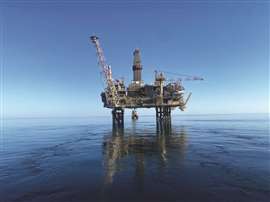 Mammoet completing weighing, transport, jacking and skidding operations for a 2,400 tonne module. (Photo: Mammoet)
Mammoet completing weighing, transport, jacking and skidding operations for a 2,400 tonne module. (Photo: Mammoet)
The scope of the work included the weighing, transport, jacking and skidding operations for a 2,400 tonne, 80 metre high Drilling Equipment Set (DES) module and a 2,350 tonne, 43 metre long, Modular Drilling Support Module (MDSM). This was achieved using a combination of Mammoet’s large jacking and skidding systems, in combination with SPMT.
Tommy Quik, project manager at Mammoet says, “The combination of Mega Jack 800 with SPMTs and heavy skidding systems was perfect for the integration operation. The Mega Jack 800, with its significant lifting power and its small footprint, provided considerable stability to the base of the modules.”
Mammoet will return for the final stage of the project, which will involve the jack-up and load-out of the complete PDQ platform (expected to weigh 20,750 tonnes). Mammoet’s largest jacking system – the Mega Jack 5200 – will be used for the operation.
Onshore lifts
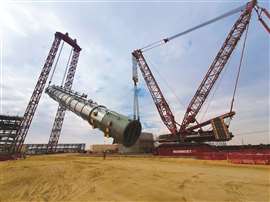 Mammoet lifts 1,600 tonne product splitter in Saudi Arabia. (Photo: Mammoet)
Mammoet lifts 1,600 tonne product splitter in Saudi Arabia. (Photo: Mammoet)
Other heavy lifts by Mammoet this year include the erection of a 1,600 tonne product splitter as part of a petrochemical plant construction project in Saudi Arabia. There were 124 other separate heavy lift operations included with this project.
Mammoet used a tower gantry lifting system and a 1,250 tonne capacity Demag CC 6800 crawler crane to lift the 129 metre tall, 10 metre wide component. The CC 6800 handled the tail, keeping it clear of the ground throughout the lift, while the gantry’s hydraulic lifting system hoisted the product splitter from the top.
Unlike most gantry lifting systems, Mammoet’s is entirely freestanding and requires no guy wires, even at a height of 130 metres. The company says this means the footprint is kept to an absolute minimum, which is an important consideration on a busy and congested site.
Finally, as previously reported, Mammoet also completed the removal and replacement of four coke drums at Texan refinery in the USA using its 5,000 tonne capacity SK350 crane.
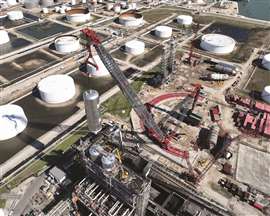 Mammoet reinstalling four large coke drums at a refinery in Texas. (Photo: Mammoet)
Mammoet reinstalling four large coke drums at a refinery in Texas. (Photo: Mammoet)
First, a 53 metre derrick was removed so the coke drums could be reached. After this, one by one, the old 270 tonne drums were removed and replaced with new, 448 tonne drums. Once in place, the derrick structure was reinstalled.
Each of the eight coke drums was handled with the SK’s auxiliary hook. On the SK, the runner hook on its own has a 600 tonne capacity, making it strong enough to lift a load as heavy as an average coke drum, which would typically require the strength of a heavy-duty main block on most cranes.
Sidney King, Mammoet project manager, says, “Using the world’s strongest land-based crane, Mammoet’s international team comprising six nationalities, led the coke drum replacement project to a successful conclusion. With zero recordables and despite some weather downtime, the SK350 was able to complete all the client’s lifts days ahead of their planned schedule, giving the turnaround an opportunity for an ahead of schedule completion.”
STAY CONNECTED


Receive the information you need when you need it through our world-leading magazines, newsletters and daily briefings.




